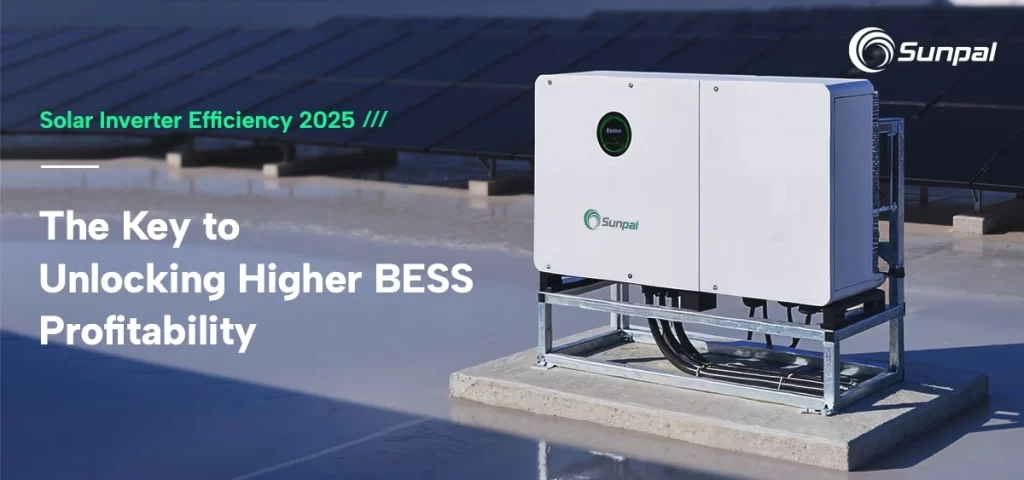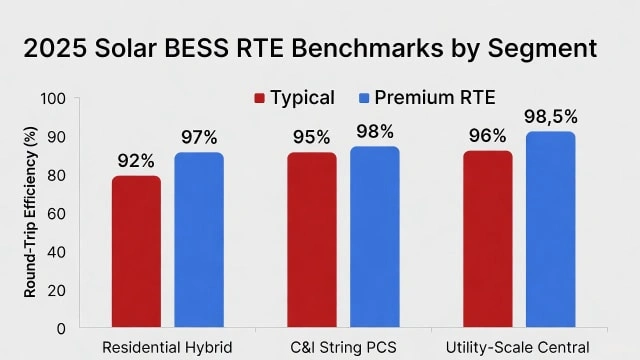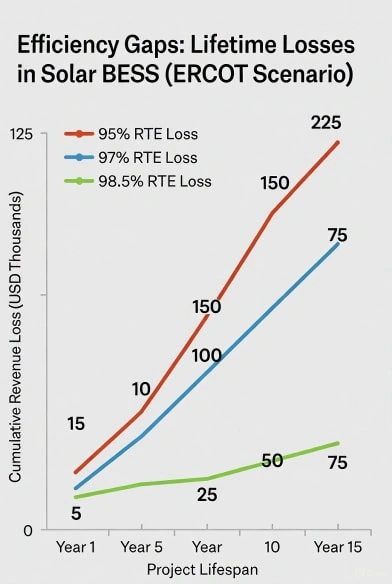
As solar energy storage systems (BESS) surge toward 92 GW of global installations this year—up 23% from 2024, per BloombergNEF—developers face a stark reality: a mere 2% dip in round-trip efficiency (RTE) can erode $200,000+ in lifetime revenue per megawatt.
In high-stakes markets like California's arbitrage plays or Australia's frequency services, optimizing solar inverter efficiency isn't optional; it's the edge that turns marginal projects profitable.
For solar companies hunting "high efficiency solar inverters" or "BESS RTE optimization," this guide unpacks 2025 trends, backed by fresh data. Discover how SiC and GaN tech, smarter topologies, and tender mandates are reshaping solar energy storage, helping businesses rank higher in ROI while slashing levelized cost of storage (LCOS).
The Solar Boom: Why BESS RTE is Your 2025 Profit Lever
Global demand for battery energy storage systems is exploding, driven by solar PV integration and grid resilience needs. BloombergNEF forecasts 247 GWh added worldwide in 2025, with utility-scale dominating 70% of deployments. Yet, amid this growth, solar inverter efficiency emerges as the unsung hero—or villain—in maximizing returns.
Round-trip efficiency (RTE) quantifies usable energy recovered after charging, storing, and discharging through DC-AC conversion. For BESS paired with solar panels, RTE blends battery chemistry (e.g., LFP at 95%+ DC efficiency) and inverter performance.
- Average 2025 systems: 94–96% RTE
- Premium setups: 98%+ RTE (Fraunhofer ISE benchmarks)
Why obsess over that "last 2%"?
In solar-plus-storage hybrids, low RTE compounds losses: every kWh cycled loses value in peak pricing windows. For example:
- 10 MW solar farm with 40 MWh BESS in Texas' ERCOT market
- At 96% RTE, forfeits $450,000 over 15 years versus 98.5% RTE
Aurora Energy Research's Q4 2025 forecast ties efficiency to 15–20% swings in IRR for solar projects.
Benchmarking Solar Inverter Efficiency: 2025 RTE Breakdown
| Technology | Peak RTE |
| Legacy silicon | 95% |
| SiC / GaN | 99%+ (lab tests, Infineon) |
Key drivers:
- Advanced Semiconductors – SiC reduces switching losses by 50% vs silicon, ideal for high-voltage solar strings.
- Topology Upgrades – Three-level NPC designs minimize harmonic distortion, boosting RTE by 1–2%.
- Thermal Innovations – Liquid cooling cuts idle losses to <0.1% rated power, crucial for off-grid setups.
Por ejemplo:
- Sungrow SBH series: 97% RTE in residential solar storage
- Huawei FusionSolar (utility): 98.5%+ RTE with GaN integration
2025 Solar BESS RTE Benchmarks by Segment:

Case Studies: Quantifying Losses in Real Solar Projects
California, USA: 5 MWh behind-the-meter BESS with 95.2% RTE hybrid inverter shaved $165,000 from arbitrage gains over 15 years.
Sydney, Australia: 20 MWh C&I solar-plus-storage upgraded from 96% → 98% RTE via SiC inverters added AU$520,000 NPV.
Germany: 100 kW commercial solar setup, 94.5% RTE forfeited €38,000 in self-consumption savings over a decade; 97.5% RTE achieved €52,000.
Efficiency isn't front-loaded cost—it's back-loaded profit.
Lazard LCOS v7.0: 1% RTE boost = $10–15/kWh lifetime savings.
Lifetime Revenue Loss Projection for 10 MWh BESS (ERCOT):

Tech Deep Dive: Engineering the Last Percent in Solar Inverters
Achieving 98%+ RTE requires layered innovations:
- Wide-bandgap materials: SiC MOSFETs handle 1,500V DC with 70% less on-resistance; GaN slashes MPPT turn-off times.
- Topology evolution: Multi-level converters (five-level active NPC) reduce voltage stress, yielding 1.5% RTE gains.
- Ultra-low idle modes & active cooling: <0.2% draw, resilient to 50°C desert deployments.
- Off-grid & hybrid systems: 2025 bidirectional designs enable V2G flows at 97% RTE (IEA-4E), transformative for solar microgrids in emerging markets.
2025 Mandates: How Tenders Are Forcing Solar Efficiency Upgrades
Regulatory tailwinds:
- Australia CIS Tender 4 – mandates 97.5% RTE for >5 MW BESS, awarding 11.4 GWh to compliant solar hybrids.
- California Building Energy Efficiency Standards – require 97%+ RTE for nonresidential BESS, unlocking SGIP rebates up to $250/kWh.
- Europe: SolarPower Europe 2025–2029 Outlook sets 98% baseline; Engie & TotalEnergies penalize below-threshold RTE.
Global Tender RTE Requirements Share:

25% of bids now premium-tier – ignoring this risks disqualification.
Sunpal's Edge: Delivering 98.6% RTE for Solar Success
Sunpal High Efficiency MPS 100KW-150KW Three Phase Hybrid Solar Inverter series verified 98.6% CEC RTE.
- Pairs with Sunpal 280 Ah LFP packs → end-to-end >98% BESS efficiency
- 8.6 MW ERCOT project: 98.2% measured RTE, adding $320,000 in value
"In solar's high-cycle world, that final percent is $20,000/MWh in preserved revenue." – Juray Zhu, CEO
Sunpal Solutions:
- 5–50 kW hybrids for C&I
- MW-scale systems for utilities
Conclusion: Maximizing ROI Through Inverter Efficiency
2025 marks a turning point for solar-plus-storage projects: every fraction of RTE matters, directly impacting project profitability, LCOS, and tender compliance. From residential hybrids to utility-scale installations, advanced technologies like SiC and GaN semiconductors, optimized topologies, and thermal management innovations are no longer optional—they are critical differentiators.
Efficiency gains translate to tangible financial benefits. Solar developers who prioritize premium inverters and compliance with emerging mandates position their projects for higher IRR, greater revenue, and long-term reliability. Contact Sunpal today to evaluate your solar-plus-storage project and unlock hidden savings through top-tier inverter efficiency.
